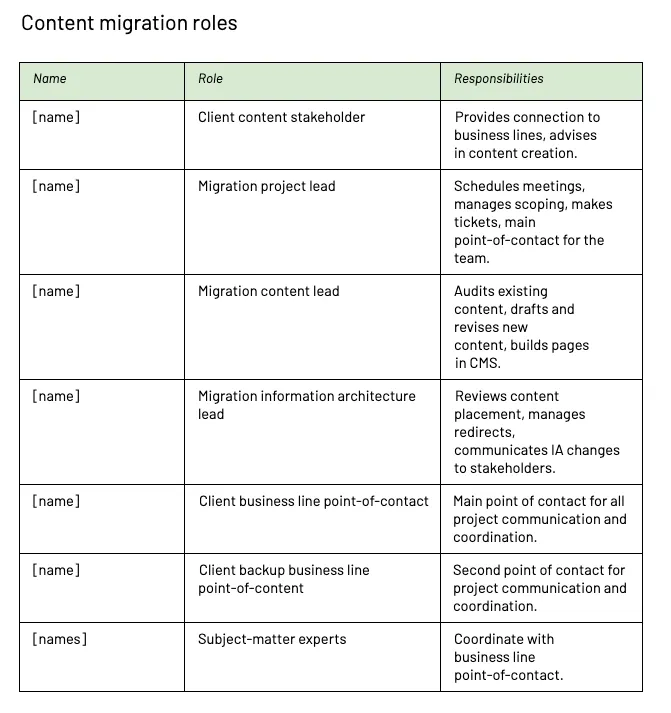
Tool
Content migration as relationship building
A practical framework for migrating content in a website redesign
If you’ve ever migrated a large website, you’ll likely agree: moving content takes work. Legacy content has to be cataloged, reviewed, reorganized, rewritten, double-checked, and re-approved. At any point in this process, seemingly small tasks can balloon in scope. That risk is even greater when it’s a large site with many different teams managing content.
Our experience has shown us that the key to running successful migrations is developing an effective working relationship with internal partners. If you want to build accurate, accessible content that continues to serve users long after the project ends, you need the cooperation of program managers and subject-matter experts. Their insight is irreplaceable and the work often can’t move forward without their participation.
To build these essential partnerships, we’ve created a relationship-first framework for content migrations. This process is designed to build trust every step of the way by listening carefully to the needs of internal partners, tailoring processes to their capacities, and demonstrating how content strategy serves their work.
Common challenges
There are a few challenges that many content strategists will find familiar when working on large-scale migration projects:
- Explaining specialized expertise: Content strategists have to explain their methods and value to subject matter experts (SMEs) who aren’t familiar with their discipline and may be skeptical.
- Tackling a backlog: Over time, policies and procedures change but the content remains the same, leading to an accumulation of “content debt” — outdated, inconsistent information.
- Navigating bureaucratic structures: It’s difficult to find the right decision-makers, establish clear authority, and manage communication bottlenecks.
- Getting access to expertise: Subject-matter experts are often quite busy and difficult to reach, but they’re also the only people who can verify that content is accurate.
- Balancing risk tolerance: Program staff are understandably hesitant about simplifying complex technical language and worried that simplification might introduce inaccuracies or legal vulnerabilities.
These aren’t just content problems, they’re people problems. They reflect the difficulties of working in organizations where expertise, authority, and accountability are distributed. The solution then isn’t just a style guide or an editorial process, but a new approach to doing the work.
A relationship-first approach
Instead of approaching content migration as merely a technical challenge for our team to solve, we frame it as organizational change that depends on building coalitions and nurturing relationships.
Our process treats each migration as its own distinct project with dedicated relationship-building, discovery, and alignment processes. This approach produces real improvements: work gets done faster, solutions actually address partners’ needs, content stays current longer, and users find information more easily.
Here’s how to put this approach into practice.
1. Establish initial relationships
We use kick-off meetings as an opportunity to inform our partners about our work and learn more about theirs. In our kick-off meetings, we give an introduction to content strategy, the goals of migration, and how this work can benefit and support their objectives, not just ours.
Benefits we highlight to partners include:
- Providing clear content to users, which allows staff to focus on complex cases rather than repeatedly answering basic questions.
- Creating alignment among teams by surfacing inconsistencies and finding consensus on important policy and process questions.
- Creating a single source of truth for both public audiences and internal staff.
After presenting our approach, we take time to learn about our partners’ work so that we can tailor the project to their specific needs and capacities.
Key questions we explore with partners include:
- Who has the authority to review and approve content changes, and what is their availability?
- What are your team’s preferred communication channels and typical response times?
- Are there any sensitive programs or content areas that will require extra care and attention?
- What are your busy seasons or periods when availability might be limited?
- What are the competing priorities or workload challenges that might limit SME availability, and how can we work around them?
- What writing and communications capacity does your team have internally?
These initial conversations lay the groundwork for the next step: building out a collaboration playbook that serves everyone’s needs.
2. Create a plan for partnership
Without clear expectations and shared understanding, content migrations often stall due to miscommunication, scope creep, and confusion about roles and responsibilities. To address that, we make a collaboration playbook for each migration that’s informed by the initial relationship-forming conversations and serves as both a lightweight project plan and an agreement about how you’ll work together. We sit down with partners to review this document, walking through project objectives, scope, responsibilities, work phases, and communication channels. Everyone involved in the migration receives a copy to ensure alignment across teams.
This collaborative approach delivers multiple benefits, including:
- Establishing clear expectations and accountability from the start.
- Creating shared vocabulary and understanding of the migration process.
- Giving partners concrete ways to track progress and raise concerns.
- Developing flexible engagement models for SMEs with varying availability.
- Documenting agreements about decision-making authority and communication patterns.
- Ensuring necessary access to subject-matter experts.
- Setting up frameworks for content maintenance after the migration.
While we start with a standardized template, each collaboration playbook is customized to fit our partner’s specific needs and constraints. Taking time to tailor and review the playbook together prevents the ambiguity and mismatched expectations that typically slow projects down. It also creates the foundation for sustainable content governance that continues after our direct involvement ends.

3. Build sustainable governance
Content migrations are often done to solve a specific problem: a pile of content debt. But content migration alone only addresses the symptom, not the underlying cause. Without addressing governance, the same issues will eventually return, requiring another migration effort. With proper governance in place, content becomes a living asset that continues to serve both the organization and its users effectively.
Our solution is to work on building internal ownership throughout the process. Subject-matter experts and program managers — not content strategists — are the ones who know when information becomes outdated or inaccurate. This is why our entire process emphasizes collaboration: by working closely together, the partners develop an understanding of how their content works, what it can do for them, and why keeping it updated matters.
As migration nears completion, we work with partners to establish a sustainable audit process that includes:
- A content inventory
- A clear review process
- Ownership of that process
- A schedule for regular review
- How any necessary changes will be implemented
When we’re successful, we accomplish more than just a content migration. We transform how organizations think about and maintain their content.
Beyond migration
The success of content work shouldn’t be measured just by completed migrations but by what comes after. When we truly succeed, we leave partners with not only better content but also the understanding and commitment to maintain it.
This relationship-first approach transforms content from a static product into an ongoing conversation between an organization and the people it serves. This is how content stops being just a deliverable and starts becoming a durable part of public service.
